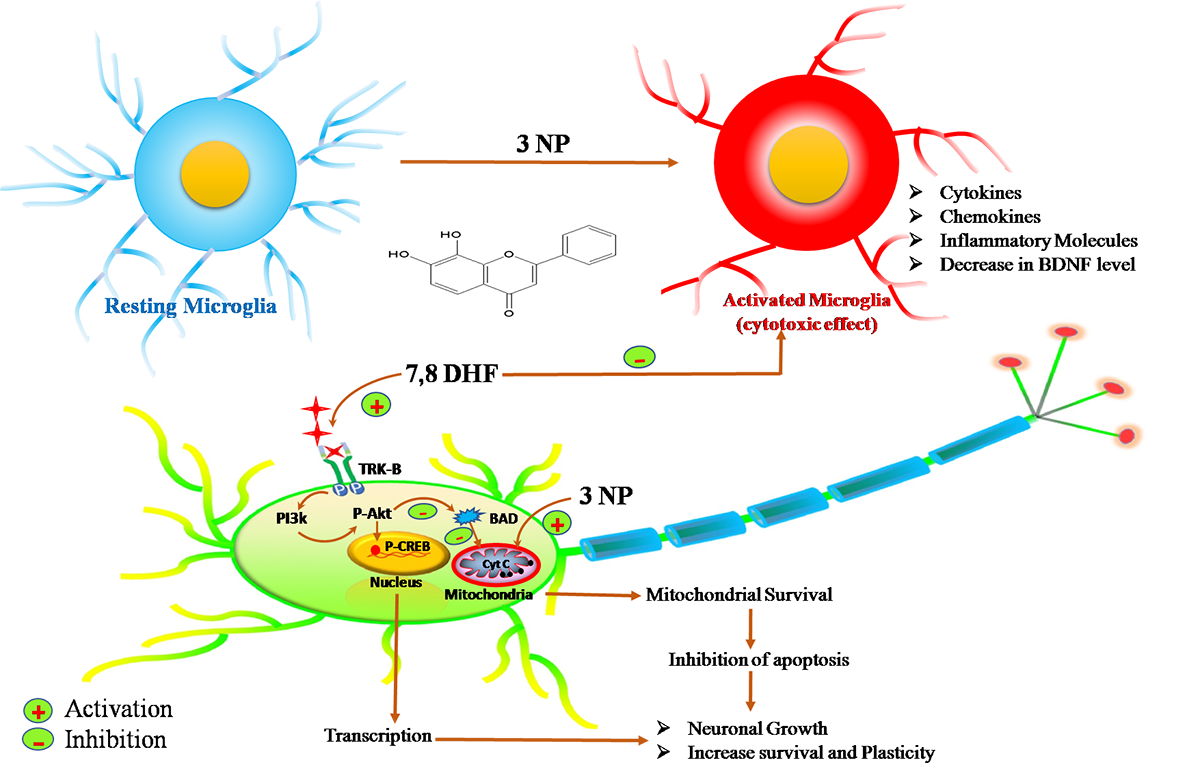Session Information
Date: Monday, September 23, 2019
Session Title: Huntington’s Disease
Session Time: 1:45pm-3:15pm
Location: Agora 3 West, Level 3
Objective: Hungtion’s disease (HD) is an autosomal governing neurodegenerative disorder caused by production of mutant hungtingtin(Htt) protein followed by death of the GABAergic neurons in the striatum. These neurons depend on an afferent supply of brain derived neurotrophic factor-(BDNF) which binds to its tropomyosin receptor kinase B (TrkB) receptor for maintaining plasticity, differentiation and survival.
Background: Impaired BDNF-TrkB signaling is assumed to be the mechanism underlying degeneration of neurons in HD. Therefore, we aimed to investigate an active molecule which mimics similar to BDNF in activating the TrkB receptor and its downstream pathway.
Method: Behavior parameter were assessed to see any neuroprotective effect of 7,8-DHF in 3-NP treated mice. Microglial activation marker, inflammatory markers and apoptotic signaling pathway were evaluated to see whether 7,8-DHF have any role in neuroprotection through these pathways. Ultra structure of mitochondria and mitochondrial protection by 7,8-DHF was evaluated through microscopy techniques.
Results: 7,8-Dihydroxyflavone (7,8-DHF), has a better BBB penetrating ability and our results stated the treatment with 7,8-DHF causes a dose dependent manner activity in ameliorating the various behavior alterations caused by 3-nitropropionic acid (3-NP). Histopathological and electron microscopy evidences from striatal region of 3-NP mice brain treated with 7,8-DHF showed more healthier neurons with intact mitochondrial morphology and very less autophagic vacuoles. These protections by 7,8-DHF may be due to an increase level of ATP which in turn down regulates cytochrome c releases from the mitochondrial matrix and inactivates Bad protein activation. It also enhanced the BDNF levels by promoting cAMP response element-binding protein (CREB) activation. Moreover, it showed an anti-inflammatory as well as anti-apoptotic potential with reduction in Iba-1, Cox-2 and Bcl-2 expression levels
Conclusion: 7,8-DHF also enhances phosphorylation of TrkB (Ty706) and Akt (Ser473/Thr308) and promotes its downstream signaling cascades in 3-NP induced striatal toxicity in experimental mice which might be the mechanism for its striatal neurons protection.
References: 1.Canals JM, Pineda JR, Torres-Peraza JF, Bosch M, Martín-Ibañez R, Munoz MT, et al. (2004). Brain-derived neurotrophic factor regulates the onset and severity of motor dysfunction associated with enkephalinergic neuronal degeneration in Huntington’s disease. Journal of Neuroscience 24: 7727-7739. 2.Liu X, Obianyo O, Chan CB, Huang J, Xue S, Yang J, et al. (2014). Biochemical and Biophysical Investigation of Brain-derived Neurotrophic Factor Mimetic 7, 8-Dihydroxyflavone in Binding and Activation of TrkB Receptor. Journal of Biological Chemistry: jbc. M114. 562561. 3.Mantamadiotis T, Lemberger T, Bleckmann SC, Kern H, Kretz O, Villalba AM, et al. (2002). Disruption of CREB function in brain leads to neurodegeneration. Nature genetics 31: 47. 4.Oliveira JM, Jekabsons MB, Chen S, Lin A, Rego AC, Gonçalves J, et al. (2007). Mitochondrial dysfunction in Huntington’s disease: the bioenergetics of isolated and in situ mitochondria from transgenic mice. Journal of neurochemistry 101: 241-249.
To cite this abstract in AMA style:
S. Ahmed, M. Kwatra, VGM. Naidu. 7,8- Dihydroxyflavone prevents 3-NitropropionicAcid (3-NP)-induced Striatal Toxicity by Modulating the TrkB receptor and Microglial Activation Pathway [abstract]. Mov Disord. 2019; 34 (suppl 2). https://www.mdsabstracts.org/abstract/78-dihydroxyflavone-prevents-3-nitropropionicacid-3-np-induced-striatal-toxicity-by-modulating-the-trkb-receptor-and-microglial-activation-pathway/. Accessed April 19, 2025.« Back to 2019 International Congress
MDS Abstracts - https://www.mdsabstracts.org/abstract/78-dihydroxyflavone-prevents-3-nitropropionicacid-3-np-induced-striatal-toxicity-by-modulating-the-trkb-receptor-and-microglial-activation-pathway/

